|
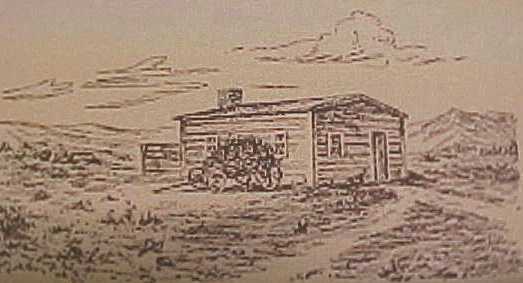
Cabin at the KC
On the morning of April 9, 1892, Rueben "Nick" Ray (sometimes spelled "Rae") and Nate Champion, in the cabin depicted above,
were beseiged by an army of about 50 cattlemen and Texas hired guns who had come to
Johnson County to clean out "rustlers." The K C was not a large ranch. Its owner, John Nolan rented it to
Nate Champion who ran only about
200 head of cattle, far less than many of the large ranchers who belonged to the
Wyoming Stock Growers Association. Instead, Champion had been elected as the foreman for
upcoming May 1892 spring roundup of the newly formed Northern Wyoming Farmers & Stock Growers Association. The
Association had been formed by small stockgrowers in response to the
monoply of the WSGA. Champion had been elected even though
he had not attended its organizational meeting. The proposed spring round up was a month ahead of the
roundup scheduled by the WSGA.
Controversies relating to roundups and the intermixing of different herds were, of course,
nothing new. As an example, Nate Champion, himself, had been involved in disputes with
Mike Shonsey, foreman of Western Union Beef Company's E K outfit. The dispute arose when
Champion's cattle were mixed in with E K cattle. Shonsey promised to separate the two
brands. He did so by scattering Champion's cattle over broad distances on the
range. David Robb "Bob" Tisdale, a participant in the attack on the K C, took some of
Champion's calves. Champion and his men, in retaliation, returned the compliment. Tisdale, a well-to-do Canadian and son of
a member of Parliament, had an unpleasant streak about him. Tisdale owned the TTT on the Natrona - Johnson
County line and had come to Wyoming from Ontario about 1890. Owen Wister in his wanderings about
Wyoming was at first impressed by Tisdale. Tisdale had a first-class personal library, but Wister was turned off by a
display of cruelty. Wister wrote in his journal that he was with Tisdale when several horses got loose.
In the pursuit, the horse Tisdale was riding became winded. Even though Wister offered to swap horses, Tisdale
began beating and kicking his horse. Wister wrote:
"I saw Tisdale lean forward with his arm down on its forehead. He told me that he would kill
it if he had a gun but he hadn't. I watched him, dazed with disgust and horror. Suddenly
the horse sank, pinning him to the ground. He could not release himself, & I ran
across to him & found only his leg was caught. So I lifted the horse & got his leg out.
I asked him if he was hurt. He said no, & got up adding "I've got one eye out all
right." The horse turned where he lay, and I caught a sight of his face where
there was no longer any left eye, but only a sink hole of blood."As quoted by
Fanny Kemble Wister,
Owen Wister Out West, Chicago, University of Chicago Press, 1958.
Trouble between small ranchers and the owners of the larger holding had been brewing ever since the
disasterous winter of 1886. Problems arose out of the loss of open range. Larger
ranchers attempted to dominate the range by either controlling water or appropriating it for
themselves on a "customary use" basis. The Two-Bar, as an
example, acquired strategically located property fronting on the Chugwater and Sibylee Creek and, thus,
controlled large areas of open range in between. Others were more brazen. Frank Wolcott's Tolland Cattle Company simply
fenced in 15 square miles of government land. Another method of grabbing off open range was "checkerboard control," in
which the large cattle company would buy or lease alternating sections. As indicated in the map below,
Sections are numbered in a six mile by six mile grid so that odd numbered sections will always be
surrounded on four sides by even numbered sections and vice-versa like the red and black sqaures of a
checkerboard. By owning all of the odd or even sections, a cattle company could erect a fence along the borders of
owned sections and preclude access to the non-owned sections. In Wyoming perhaps the most famous example of checkerboard
control was the British-owned Douglas-Willan Sartoris Cattle Co. on the Little Laramie. As will be observed, the fence
is constructed primarily on the odd numbered sections owned by the cattle company.
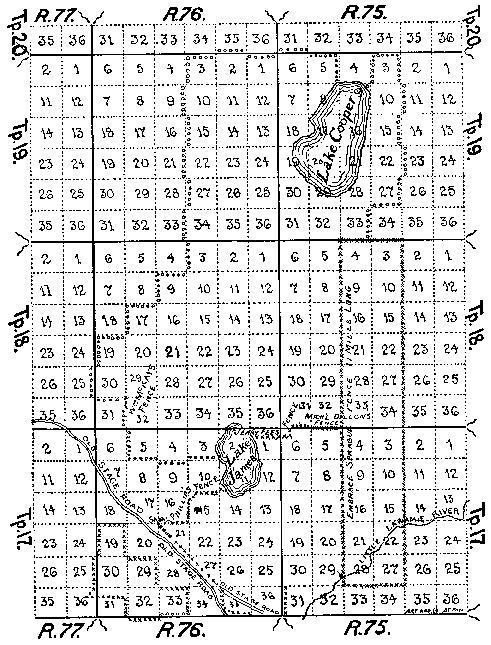
Map of fence around holdings of Douglas-Willan Sartoris Cattle Co.,
Albany County, 1889.
The Douglas-Willan Sartoris Cattle Co., named for its two principals, John H. "Jack" Douglas-Willan (1852-1898) and
Lionel Charles George Sartoris (1863-1911) acquired from the Wyoming Land and Improvement Company various odd-numbered
sections and constructed fencing as shown in the above diagram. The fencing was constructed in the odd-numbered sections, four inches
in from the line. Each numbered section in the above-diagram constitutes roughly one square mile. At the section corners, the
fencing left a slight gap of about eight inches where the section marker was located. The effect was to fence in 200 square miles
of publicly owned lands in even-numbered sections. The scheme was held by the Territorial Supreme Court to
be legal. See United States v. Douglas Willan Sartoris Co., 3 Wyo 287, 22 P. 92 (1889).
The large ranchers contended that much of their losses were incurred because of
unbridled rustling by small "nesters." Among other things, it was contended that railroad contractors fed their crews with
beef purchased from the rustlers. Accordingly, cattlemen took matters into their own
hands. Among those hanged without trial were Jim Averell, the keeper of a modest
road ranch, and his wife
Ella Watson. Averell attracted the interest of large cattlemen when on April 7, 1889, he wrote
the Casper Weekly Mail of the cattle interests:
They are land-grabbers, who are only camped here as speculators in land under the desert land act. They are opposed to
anything that would settle and improve the country or make it anything but a cow pasture for eastern
speculators. It is wonderful how much land some of these land sharks own -- in their minds -- and how firmly they are organized to keep Wyoming from being settled up.
They advance the idea that a poor man has nothing to say in the affairs of this country, in which they are wrong, as the furture land owner in
Wyoming will be the people to come, as most of these
large tracts are so fradulently entered now that it must ultimately change hands and
give the public domain to the honest settler.
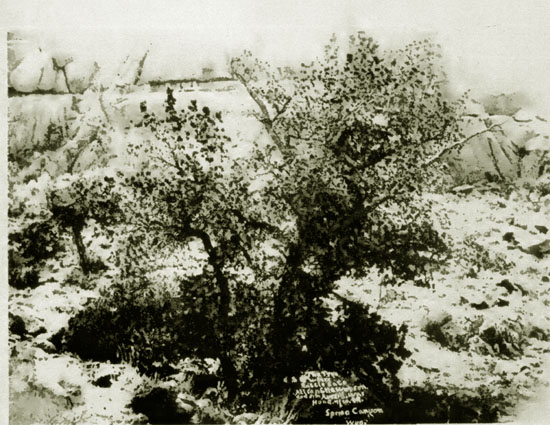
Tree upon which Ella Watson and James Averell were hanged, July 20, 1889, Spring
Canyon.
The murder was justified by claims that Averell and Watson were rustlers; that
Watson had been the inmate of a disorderly house; and that she was known as "Cattle Kate."
Some newspapers were aligned with the cattle interests. Thus the Cheyenne Sun wrote,
""The woman was as desperate as a man, a
daredevil in the saddle,
handy with a six-shooter and as adopt with the
lariat and branding iron." Watson was accused under the name "Kate Maxwell" of having robbed a faro dealer,
and having killed a black boy.
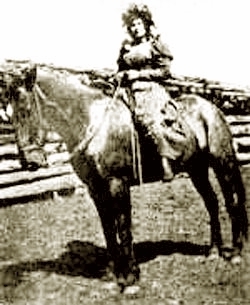 Ella Watson
Ella Watson
There really was a Kate Maxwell, a " working lady" of dubious reputation, possibly originally from Chicago
where she had worked in dance halls. The only diffiulty was that Ella Watson was not Kate
Maxwell. The actual Kate Maxwell worked in Bessemer to the west of Casper and about twenty miles from
where Watson and Averell lived. The "spin" put on the events by the cattle interests was, however,
successful. The name "Cattle Kate" has stuck.
In addition to Averell and Waton, Tom Waggoner, an alleged horse
thief, was hanged and his body left for the maggots in 1891. It was contended that
Waggoner had amassed a fortune of $30,000 to $70,000 from stolen horses, not withstanding, that he
resided with his wife in a two-room sparsely furnished cabin. One of the two rooms was an
atttached stable. There is also, perhaps, a lingering suspicion that Waggoner's death related to
alleged rustling from Elias Whitecomb's Standard Cattle Co. Tom Waggoner had loaned "Jimmy the
Butcher" money to establish his butchering business. When Jimmy was arrested for rustling Sandard Cattle
Company beeves, Waggoner posted Jimmy's bond. Jimmy also ended up dead. He was buried beside a house
belonging to a "cattle detective" working for the Standard Cattle Company.
One cowboy, John J. Baker, later recalled that some Texas guns had been brought in to get rid of
alleged rustlers:
There was one slaughter of nine old rawhides that were camped on Big Dry Creek near the
Carter Cattle Co.'s outfit. The men were trapping wolves for the hide and bounty as a
great many of the old waddies did during the winter. They were not rustling cattle and in fact
were out of the cattle business. A bunch of restler hunters made a surprise
attack on the camp and killed the nine trappers. They received the $450. bonus for the
slaughter and that was what they were after.
Nor were organized attacks by large stockgrowers on homesteaders limited to Wyoming. In Nebraska,
Isom Prentice "I. P." Olive, reputedly the wealthiest stockgrower in
Nebraska, organized efforts to drive homesteaders off the land culminating with the 1878 sadistic hanging of
homesteaders Luther M. Mitchell and Ami Ketchum.
The hanging was by stangulation rather than a drop. As
Mitchell and Ketchum strangled, they were burned alive with a fire lit beneath them. When the bodies
were discovered Ketchum was still hanging from an elm tree, his legs burned. Mitchell's rope had burned off but
one arm was still suspended upwards connected to Ketchum by a set of handcuffs. The other arm
was burned off to the shoulder. Olive was convicted of homicide but the Nebraska Supreme Court overturned the conviction on the
basis that the trial had to be conducted in the county in which the crime had been committed. Since
Custer County had not yet been organized, the trial had to be retried in a county court. The county judge
dropped the charges. Olive was like the fictional Liberty Valence and had killed at least nine men. Two, James Crow and
Turk Turner were caught skinning an Olive steer. They were tied up in the wet steer hide and left out in
the hot Texas sun to be crushed to death as the hide shrank.
After Olive was released from prison following the reversal of his conviction, he was stalked by
a father and son. In 1886, Olive having lost his fortune, was running a stable in Trail City, Colorado. On August 16, 1886,
in Haynes Saloon, Olive was gunned down by Joe Sparrow, a 26 year-old cowboy who allegedly owed Olive $10.00.
Sparrow's conviction in his first trial was overturned. A second trial ended with a jury deadlock and he
was acquitted in the third.
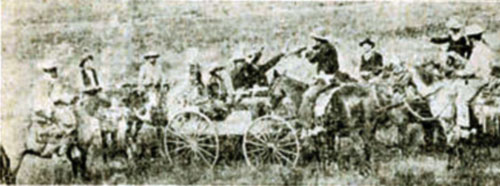
Illustration of the taking of Ketchum and Mitchell by I. P. Olive and his men
From A. O. Jenkins,
"Olive's Last Round-up" Sherman County Times c. 1930.
Other efforts were made to control small ranchers, "grease pots" as they were called, from branding as their own mavericks or strays. Cowboys
who were suspected of branding mavericks were blacklisted and precluded from
obtaining employment with any member of the WSGA. Small ranchers found difficulties in participation in the
roundups. Each roundup crew was known as a "wagon." In the 1883 Powder River roundup some
27 wagons participated, but by 1887 there were only four, the smaller ranches being eliminated. The blackballing
of the smaller ranchers from round-ups, however, backfired. The smaller ranchers simply organized
their own earlier round-ups and could thus brand and claim as their own all of the mavericks on the
range. Granville Stuart (1834-1918), for several years the President of the Board of Stock
Commissioners of Montana, later recalled one blacklisted rancher who did his own early roundup:
Near our home ranch we discovered one rancher whose cows
invaiably had twin calves and frequently triplets, while the
range cows in that viciinity were nearly all barren and would
persist in hanging around this man's corral, envying his
cows their numerous children and bawling and
lamenting their own childless state. This state of
affairs continued until we were obliged to call around
that way and threaten to hang the man if his cows had any
more twins."
Regardless of such efforts to stop rustling, the problem continued. In Johnson County, as
an example, there was the "Hole-in-the-Wall," wherein resided various outlaws who preyed on
cattle interests such as J. M. Carey's CY Ranch. Johnson County ranchers were predominately
small growers.
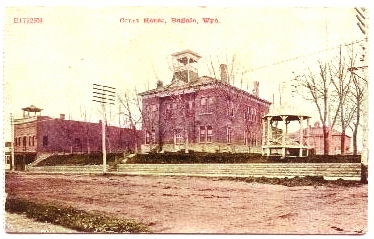
Johnson County Courthouse, Buffalo, Wyo.
Thus, a plan was devised by members of the
WSGA and the Cheyenne Club to send an expeditionary force into Johnson and Converse
Counties to clean out the rustlers. In November 1891, Thomas Calton Smith, a former deputy United States
marshal from the Indian Territory (present day Oklahoma), was employed to recruit a
force of gunmen from Texas. The Texans were promised $5.00 a day plus expenses. A $3,000.00 insurance
policy would be purchased for each and a $50.00 bonus would be paid for each "rustler" killed.
The plan called for a force of over 50 men to proceed to
Casper by train. From there, under the command of Deer Creek ranchman Major Frank
Wolcott (1840-1910), by horseback and wagon, the force would proceed northward to
Buffalo and replace the county government with individuals who would be more favorable to
the large cattle interests.
Second in command was to be English-born Fred Hesse, former foreman of
Moreton Frewen's 76 outfit. There was a certain degree of irony in the complaints by the larger
cattlemen. In addition to the Union Cattle Co. noted above, some had "mistakenly" applied an iron
to cattle they did not own. As an example, Arthur T. Corlett, the brother of one of Major Wolcott's
personal lawyers William W. Corlett, had been known to increase the size of his herds through
the use of an iron. Hesse, himself, had come up from Texas in 1880 as a cowboy. By 1882 while working for
Moreton Frewen, Hesse accumulated his own herd. Such "increase" in herds resulted in the tale allegedly told by
Bill Nye: "Three years ago a guileless tenderfoot came into
Wyoming, leading a single Texas steer and carrying a branding iron; now he
is the opulent possessor of six hundred head of fine cattle--the ostensible
progency of that one steer."
[Writer's note: The writer has been unable to find the original version of the story in Nye's books. The quotation comes from Earnest Stables Osgood's 1929 The Day of the Cattleman which
cites the Rocky Mountain Husbandman, June 14, 1883, as quoting the Laramie
Boomerang. The story has been repeated by numerous
writers. In the various versions, the herd has grown from 600 to 6,000. Nye did, however, in his 1887
Remarks allude to the growth of herds through the use of a branding iron in his reference to
"a cattle man, who had just moved on to the range with a government mule and a branding iron, intending to slowly work himself into the stock business."]
Hesse had a reputation in Johnson County as one not to be messed with. It was popularly believed, perhaps
mistakenly, that Hesse was behind the bushwhacking of local cowboys Orley "Ranger" Jones and
Johnny Tisdale. Jones had embarrassed Hesse in a local saloon. Tisdale had voiced opposition to the
large ranchers.
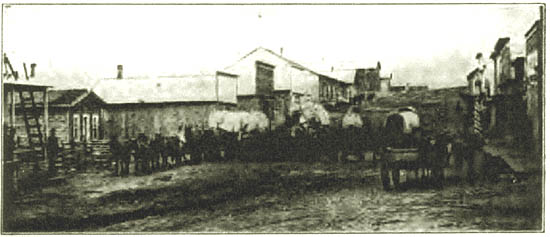
Buffalo, approx. 1890.
The plan called for telegraph wires into Buffalo to be cut in advance, so as
to preclude advance warning of the invasion. Allegedly, there had been prepared a "dead list" containing
the names of those to be eliminated. Various sources put the numbers of names on the
dead list between 30 and 70. Supposedly included on the list were Johnson County sheriff William
"Red" Angus, three Johnson County commissioners, and Northern Wyoming Farmers & Stock Growers Association roundup foreman, Nate
Champion. Additionally, Phil DuFran, former foreman for Sir Horace Plunket, was employed as a "cattle detective" to
go into Buffalo and act as a spy to provide intelligence to the invaders. DuFran had participated with
I. P. Olive in the hanging and burning of Luther Michell and Ami Ketchum. He turned state's evidence and
with the ultimate acquital of Olive never tried.
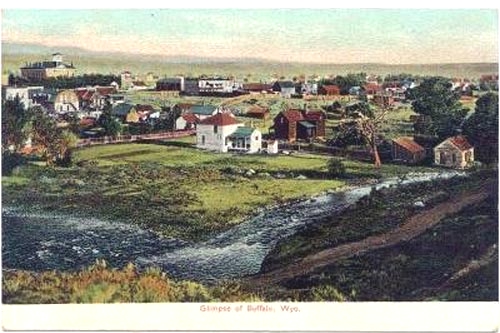
Buffalo, 1890's
Major Wolcott, manager of the Scottish-owned V R on Deer Creek and a one-time Converse County Commissioner,
received his military title in the Civil War. President Grant appointed
Wolcott as United States Marshal. In that capacity Wolcott also served as
warden of the territorial prison in Laramie City, but
was fired by President Grant after Grant was innudated with complaints that
Wolcott was obnoxious, hateful, "overbearing and abusive," and "insolent and dishonest."
His private life was allegedly "corrupt and disgraceful." See Larson, History of Wyoming, Second Ed. revised, p. 124. But
as observed by Professor Larson:
Such terms were, of course, mild in comparison with those which Johnson
County people would apply to him twenty years later when he was a
leader of the big cattlemen's invasion of their county.
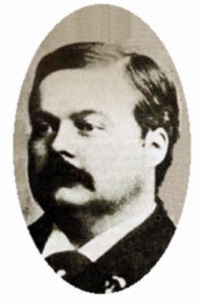 Frank Wolcott
Frank Wolcott
Later Wolcott was a justice of the peace. On one occasion, Wolcott was allegedly beaten up. The assailant
was supposedly give a $40.00 suit for the deed. Nevertheless, Wolcott continued his reputation for
arrogance. An example of Wolcott's attitude as to legal niceties occurred
when Wolcott was servicing as justice of the peace. A poor musician who made his
living by playing in saloons for $2.50 a day
was brought before Wolcott on first appearance on a charge of grand larcency. The evidence was
wholly lacking and Wolcott was, thus, required to discharge the defendant. Nevertheless, Wolcott proceeded to
fine and imprison the defendant without trial and over the remonstrance of the prosecuting attorney. Justice Micah
Saufley of the Territorial Supreme Court explained what happened:
* * * Justice Wolcott, without any charge being made against Bachman, without
any evidence heard, without even the form or pretense of a trial, conceived
the idea of sending Bachman to jail for three months, and fining him $100,
on the supposition that he was a vagrant. I will here quote a part of the
testimony of Mr. Nichols, the prosecuting attorney in the grand larceny
examination, and a part of the testimony of Mr. Camplin, who represented
Bachman. The defendant, Wolcott, did not testify.
In reply to a question by plaintiff's counsel, asking what transpired at
the conclusion of the investigation of the larceny charge, Mr.
Nichols said: "He [Wolcott] said a great deal. He called the gentleman up,
and lectured him for quite a long time. He then made the remark that he was
going to sentence him to pay a fine of $100, and imprisonment in the county
jail at hard labor for three months, on the ground that he was a vagrant.
He said it was not probably just in accordance with law to do that.
Ordinarily, a man ought to be charged with that offense, but inasmuch
as the man was before him, he would waive the technicalities of the law,
and would assume the responsibility, and did not want any advice from the prosecuting attorney. Question. Did you attempt to advise him? Answer. I did. He said he was running that himself, and would take the responsibility. Q. Did you hear the defendant make a demand for a trial,--the defendant in that case and the plaintiff in this case. A. It is my recollection that his counsel demanded it, and I think the defendant said something about it, and objected to being sentenced without a trial, and wanted a trial. Q. Do you know whether or not it was refused by the defendant, Wolcott? A. Yes, sir; I know that he said he could not have any trial." In a few minutes after this extraordinary proceeding had ended. Nichols met the justice in front of his office, and remonstrated with him on the illegal course he had taken, and asked an explanation. To this Wolcott responded that they did not try cases in this territory according to law, but took a short cut sometimes; that he knew he had not followed the law, but he did it thinking it necessary,--the law didn't cut any figure in a case of
that kind. The attorney then tried to induce the justice to go back and
vacate the order he had made, but he refused, saying he would take his
chances; that he didn't like for men to live as Bachman, that it did not
make any difference about the law; that the county ought not to be put to
the expense of a trial; that he knew he had not proceeded according to law,
but he was going to teach Bachman a lesson, and was going to see that his
order was carried out. Wolcott v. Bachman, 3 Wyo. 335, 23 P. 673 (1890), dissenting opinion.
Next page, Johnson County War continued, the seige at the KC and the murder of
Nate Champion and Nick Ray.
.
|